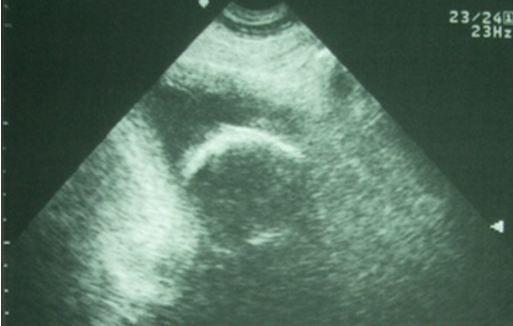Calcified Foley Balloon Causing Urinary Retention
Figure. (Click to enlarge image of sonograph study)

A 63-year-old male presents to the ED with a chief complaint of urinary retention and a secondary complaint of shortness of breath. He states that he has an enlarged prostate and a “hypo-spade” of his penis hole as well as hypertension and CHF. Oddly he is not taking alpha-blocker and he states he has never been offered corrective surgery for hypospadias. Instead he straight caths himself, but he has been having difficulty getting urine to flow for the past 2 days. He has a PCP but has not seen a urologist in “years.”
He denies any fever, vomiting, chest pain, change in his chronic leg swelling, cough, or other complaints.
He is in mild respiratory distress, but vital signs and pulse-ox are normal. He has both pulmonary rales and peripheral edema, but his heart sounds are normal. Despite his hypospadias, his bladder doesn’t feel enlarged.
You order a cath urinalysis, a chest film, and some blood work. The nurse is unable to pass a standard Foley or a coude (French for “elbow”) catheter, and asks if you could try the Foley and/or do a quick bedside ultrasound of his bladder. You pick option two and obtain the following sonographic image (Figure, above).
His labs later come back and show that he has a raging UTI, elevated BUN and creatinine, and elevated B-natriuretic peptide level.
A. What does the ultrasound show?
B. What should be your next step or steps?
Answer A: Calcified Foley Balloon
The ultrasound shows a large calcified object within the bladder that casts an acoustic shadow. The urine and the shadow are dark and the bladder wall and the calcifications are bright. The bladder is actually not distended. You wonder if it could be a huge bladder stone, but when you mention it to the patient he tells you, “Oh yeah, about 6 months ago a catheter tip broke off in there. They recommended surgery, but I decided to see what would happen if I left it alone. It hasn’t seemed to bother me, so I never went back for the surgery.”
Answer B: Call the Urologist
Your next move should be to call a urologist, which you do. The urologist says to keep him NPO because he’ll need a cystotomy in the OR to remove the Foley balloon.
Discussion
Urinary retention usually presents with the classic triad of an inability to urinate despite a strong urge, suprapubic pain and a distended bladder. In severe cases, overflow incontinence and renal damage may occur. The condition can be painless when chronic or when there is paraplegia or decreased sensorium. Urinary retention is much more common in men due to prostatic causes and the higher risk of other causes of obstruction from the longer male urethra. Remember that benign prostatic hypertrophy often starts in the peri-urethral prostate so the prostate may not necessarily feel enlarged on exam.
Confirmation of urinary retention is usually by measuring post-void residual (PVR) urine by Foley catheter or estimating PVR by imaging, such as bedside ultrasound. A PVR <50 mL is normal, while 50 mL-100 mL is borderline. Values >1L are associated with an increased risk of kidney damage so a BUN and creatinine should be ordered when the PVR exceeds 1 liter.
There are a variety of causes of urinary retention. The Table provides details and a mnemonic.
Treatment of urinary retention usually requires an indwelling Foley catheter with a leg bag until the primary problem can be treated or corrected. This may include stopping offending medications, medical or surgical treatment of infections, BPH or other obstructive conditions, and/or ruling out neurologic emergencies when there is concern for such a condition.
MS, multiple sclerosis; GBS, Guillain-Barré Syndrome; H1, type 1 antihistamines, such as diphenhydramine.
Click here for information on:
" target="_blank">
